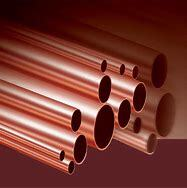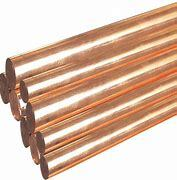1. Introduction
Just 24 hours ago, the London Metal Exchange reported a 3.2% spike in copper futures—the sharpest single-day rise in over two months—driven by renewed infrastructure spending in Southeast Asia and tighter scrap supply chains. This volatility makes choosing the right copper product not just a technical decision, but a financial one too. Among the most versatile yet misunderstood copper forms is the humble copper rod.

Whether you’re grounding an industrial substation, brazing HVAC components, or sourcing materials for recycling, the term ‘copper rod’ can refer to wildly different products: solid electrolytic-tough-pitch (ETP) rods, copper-bonded steel earth rods, or even specialty welding rods. Let’s untangle the confusion and compare what really matters.
2. Types of Copper Rods and Their Core Uses
Not all rods labeled ‘copper‘ are created equal. The three dominant categories serve distinct purposes:
- Solid copper rod (also called copper round bar or round bar copper): Made from >99.9% pure copper, this is ideal for electrical busbars, machining, and high-conductivity applications.
- Copper bonded earthing rod (or copper bonded ground rod): A steel core electroplated with a thick layer of copper, offering strength plus corrosion resistance for grounding systems.
- Copper clad steel ground rod (sometimes called copper clad earth rod): Similar to bonded rods but uses metallurgical cladding instead of plating, yielding better adhesion and longevity in harsh soils.
Each type balances cost, conductivity, tensile strength, and corrosion resistance differently—which directly impacts performance and value.
3. Copper Rod for Earthing: Bonded vs. Clad vs. Solid
For earthing systems, conductivity and durability underground are paramount. Solid copper rods offer the best conductivity and longest life but come at a premium—often 3–5x the cost of alternatives. That’s why most commercial projects opt for copper bonded or copper clad options.

Copper bonded steel combines a high-strength steel core with a continuous copper layer (typically 0.25mm thick). It’s cost-effective and widely used, though the bond can degrade over decades in acidic soil. In contrast, copper clad steel earth rods fuse copper and steel at the molecular level during manufacturing, resisting delamination and offering superior long-term reliability—especially in coastal or high-moisture environments.
When comparing earthing rod price points, solid copper might cost $80–$120 per 3m rod, while copper bonded versions range from $25–$45, and copper clad sits around $35–$55. For large-scale installations, that difference adds up fast.
4. Copper Rods in Joining Applications: Brazing and Welding
Beyond grounding, ‘copper rod’ often refers to filler materials like copper brazing rod or copper welding rod. These aren’t structural rods—they’re consumables used to join metals.
Copper to copper brazing rods (often phosphorus-deoxidized) are perfect for HVAC work, especially when connecting aircon copper pipe or ac copper tubing without flux. They melt around 700–800°C and create strong, leak-proof joints. Meanwhile, copper to copper welding rod formulations are rarer; true copper welding usually requires inert gas shielding and preheating due to copper’s high thermal conductivity.
Note: Many so-called ‘copper welding rods’ are actually bronze or silicon bronze alloys—not pure copper—because they flow better and reduce cracking. Always check the spec sheet before buying copper rod for welding.

5. How Copper Rod Differs from Copper Strip and Round Bar
People often confuse copper rod with copper strip, copper tape, or copper round bar—but dimensions and applications vary significantly.
A copper rod is typically round and ≥6mm in diameter, used for grounding, machining, or as feedstock. Copper round bar is essentially the same thing—just a more precise engineering term. In contrast, copper strip (or flat copper strip) is thin, flat, and rolled—ideal for earthing straps (e.g., copper earth strip 25x3mm), busbar laminations, or EMI shielding. Variants like beryllium copper strip or nickel plated copper strip serve specialized roles in electronics and aerospace.
Recyclers should note: stripping copper wire for scrap yields higher returns than burning copper wire for scrap (which damages purity and is often illegal). The best way to strip copper cable involves mechanical strippers—not open flames—to preserve the 1oz copper price value.
6. Pricing Trends and Practical Sourcing Tips
With copper rod price and copper strip price both sensitive to LME fluctuations, timing purchases matters. As of this week, expect to pay $8–$12/kg for solid ETP copper rod, while copper bonded ground rod runs $3–$5/kg due to its steel content.
For buyers searching ‘copper strip near me’ or ‘copper bars for sale,’ consider flexible copper bus bar options if you need bendable conductors. And remember: copper pipe price (for 15mm copper pipe or 22mm copper tube) operates on a separate market than rod pricing—don’t assume correlation.
7. Conclusion
Choosing the right copper rod hinges on your application: go solid for maximum conductivity and longevity, bonded for budget-friendly earthing, or clad for demanding environments. For joining tasks, verify whether you truly need a copper brazing rod versus a copper alloy filler. And always factor in current copper ingot price swings—they ripple through everything from earthing rod price to copper strip roll costs. In today’s volatile market, knowledge isn’t just power—it’s savings.
Our Website founded on October 17, 2012, is a high-tech enterprise committed to the research and development, production, processing, sales and technical services of ceramic relative materials such as What’s. Our products includes but not limited to Boron Carbide Ceramic Products, Boron Nitride Ceramic Products, Silicon Carbide Ceramic Products, Silicon Nitride Ceramic Products, Zirconium Dioxide Ceramic Products, etc. If you are interested, please feel free to contact us.

